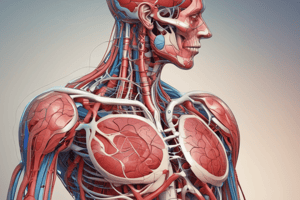Podcast
Questions and Answers
Define physiology and describe the relationship between physiology and anatomy.
Define physiology and describe the relationship between physiology and anatomy.
Physiology is the study of normal functioning of a living organism and its component parts, including all chemical and physical processes. Anatomy is the study of the body's structure.
Name the different levels of organization in the biosphere.
Name the different levels of organization in the biosphere.
Atom, molecules, cell, tissues, organs, organ systems, organism, populations of one species, ecosystem of different species, biosphere.
Name the 10 systems of the body and give their major functions.
Name the 10 systems of the body and give their major functions.
- Integumentary: external protection for internal environment. 2. Respiratory: exchange gases O₂ and CO₂. 3. Musculoskeletal: support and body movement. 4. Nervous: coordinates body functions. 5. Cardiovascular: move blood and nutrients. 6. Endocrine: coordinates body functions. 7. Reproductive: produces egg/sperm. 8. Urinary: remove excess water and liquid materials. 9. Digestive: process food/water and eliminate wastes. 10. Immune: protect body from invaders.
What does 'Physiology is an integrative science' mean?
What does 'Physiology is an integrative science' mean?
Define homeostasis and name some regulated variables that are maintained through homeostasis.
Define homeostasis and name some regulated variables that are maintained through homeostasis.
Name the 4 major themes in physiology.
Name the 4 major themes in physiology.
Put the following parts of a reflex in the correct order for a physiological response loop: input signal, integrating center, output signal, response, sensor, stimulus, target.
Put the following parts of a reflex in the correct order for a physiological response loop: input signal, integrating center, output signal, response, sensor, stimulus, target.
What is the name for daily fluctuations of body functions such as blood pressure, temperature, and metabolic processes?
What is the name for daily fluctuations of body functions such as blood pressure, temperature, and metabolic processes?
Distinguish between tissues and organs.
Distinguish between tissues and organs.
What is the role of the x-axis and y-axis in a graph?
What is the role of the x-axis and y-axis in a graph?
What are dependent and independent variables?
What are dependent and independent variables?
What are teleological and mechanistic approaches?
What are teleological and mechanistic approaches?
What are the internal and external environments for a human?
What are the internal and external environments for a human?
Name some organs or body structures that connect directly with the external environment.
Name some organs or body structures that connect directly with the external environment.
Which organ systems are responsible for coordinating body function?
Which organ systems are responsible for coordinating body function?
Which organ systems are responsible for protecting the body from outside invaders?
Which organ systems are responsible for protecting the body from outside invaders?
Flashcards are hidden until you start studying
Study Notes
Physiology and Anatomy
- Physiology studies the normal functioning of organisms and their parts, including chemical and physical processes.
- Anatomy focuses on the body's structure, providing a foundation for understanding physiological functions.
Levels of Organization
- Organization progresses from atoms to molecules, then to cells, tissues, organs, organ systems, and ultimately organisms.
- Includes populations of one species, ecosystems of different species, and the biosphere.
Body Systems and Functions
- Integumentary: Offers external protection.
- Respiratory: Facilitates gas exchange (O₂ and CO₂).
- Musculoskeletal: Provides support and allows movement.
- Nervous: Coordinates body functions.
- Cardiovascular: Transports blood and nutrients.
- Endocrine: Regulates bodily functions through hormones.
- Reproductive: Produces gametes (egg/sperm).
- Urinary: Eliminates excess fluids and materials.
- Digestive: Processes food and eliminates waste.
- Immune: Defends against pathogens.
Integrative Nature of Physiology
- Physiology is integrative; body systems function in tandem.
- Changes in one system often impact others, e.g., fluid volume affecting blood pressure (BP).
Homeostasis
- Homeostasis maintains internal stability, ensuring that variables like BP and body temperature remain regulated.
Major Themes in Physiology
- Structure-function relationships highlight how anatomy impacts physiology.
- Biological energy utilization focuses on energy transformations within organisms.
- Information flow examines how signals are transmitted and processed.
- Homeostasis and control systems concentrate on mechanisms that sustain balance.
Reflex Response Loop
- The physiological response follows this sequence: stimulus → sensor → input signal → integrating center → output signal → target → response.
Circadian Rhythms
- Daily fluctuations in body functions, including BP and metabolic activities, are referred to as circadian rhythms.
Tissues vs. Organs
- Tissues are groups of similar cells performing related functions.
- Organs are made up of multiple tissue types, functioning as structural and functional units.
Graphing Variables
- The x-axis represents the independent variable, while the y-axis shows the dependent variable.
Dependent and Independent Variables
- The dependent variable is measured by the experimenter, whereas the independent variable is manipulated.
Teleological vs. Mechanistic Approaches
- Teleology addresses the "why" behind physiological processes, while mechanistic analysis focuses on the "how."
Internal and External Environments
- The external environment includes skin, hair, and nails, while the internal environment refers to the extracellular fluid.
Types of Studies
- Blind studies: Subjects are unaware of their treatment status.
- Double-blind studies: Both subjects and experimenters are unaware of treatment allocation.
- Crossover studies: Two groups alternate between receiving treatment and placebo.
Control System Components
- Sensors detect changes in the environment; for example, a thermometer measuring temperature.
- Targets execute responses, akin to a heater activating when a temperature drop is sensed.
Connection to the External Environment
- Structures interfacing with the external environment include the nasal and oral cavities, ears, and various gland ducts (sweat, mammary).
- The digestive, urinary, reproductive, and respiratory systems also connect to the outside.
Coordination of Body Functions
- The nervous and endocrine systems are primarily responsible for regulating and coordinating the body's functions.
Protection from Invaders
- Systems protecting the body from external threats include the skin, immune, digestive, and cardiovascular systems.
Studying That Suits You
Use AI to generate personalized quizzes and flashcards to suit your learning preferences.




